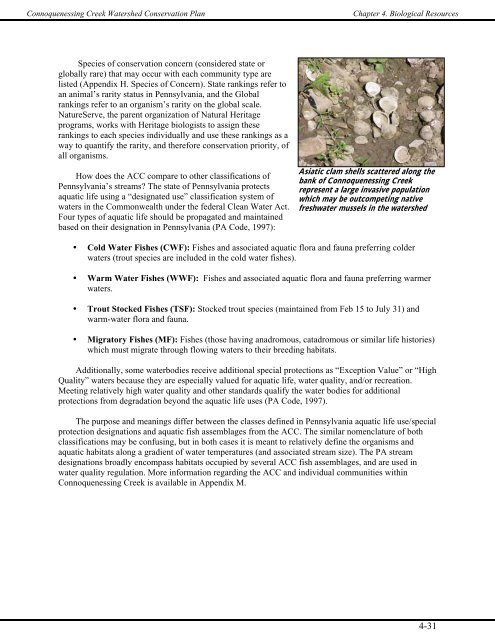CHAPTER 4 - Western Pennsylvania Conservancy
CHAPTER 4 - Western Pennsylvania Conservancy
CHAPTER 4 - Western Pennsylvania Conservancy
Create successful ePaper yourself
Turn your PDF publications into a flip-book with our unique Google optimized e-Paper software.
Connoquenessing Creek Watershed Conservation Plan<br />
Chapter 4. Biological Resources<br />
Species of conservation concern (considered state or<br />
globally rare) that may occur with each community type are<br />
listed (Appendix H. Species of Concern). State rankings refer to<br />
an animal’s rarity status in <strong>Pennsylvania</strong>, and the Global<br />
rankings refer to an organism’s rarity on the global scale.<br />
NatureServe, the parent organization of Natural Heritage<br />
programs, works with Heritage biologists to assign these<br />
rankings to each species individually and use these rankings as a<br />
way to quantify the rarity, and therefore conservation priority, of<br />
all organisms.<br />
How does the ACC compare to other classifications of<br />
<strong>Pennsylvania</strong>’s streams? The state of <strong>Pennsylvania</strong> protects<br />
aquatic life using a “designated use” classification system of<br />
waters in the Commonwealth under the federal Clean Water Act.<br />
Four types of aquatic life should be propagated and maintained<br />
based on their designation in <strong>Pennsylvania</strong> (PA Code, 1997):<br />
Asiatic clam shells scattered along the<br />
bank of Connoquenessing Creek<br />
represent a large invasive population<br />
which may be outcompeting native<br />
freshwater mussels in the watershed<br />
• Cold Water Fishes (CWF): Fishes and associated aquatic flora and fauna preferring colder<br />
waters (trout species are included in the cold water fishes).<br />
• Warm Water Fishes (WWF): Fishes and associated aquatic flora and fauna preferring warmer<br />
waters.<br />
• Trout Stocked Fishes (TSF): Stocked trout species (maintained from Feb 15 to July 31) and<br />
warm-water flora and fauna.<br />
• Migratory Fishes (MF): Fishes (those having anadromous, catadromous or similar life histories)<br />
which must migrate through flowing waters to their breeding habitats.<br />
Additionally, some waterbodies receive additional special protections as “Exception Value” or “High<br />
Quality” waters because they are especially valued for aquatic life, water quality, and/or recreation.<br />
Meeting relatively high water quality and other standards qualify the water bodies for additional<br />
protections from degradation beyond the aquatic life uses (PA Code, 1997).<br />
The purpose and meanings differ between the classes defined in <strong>Pennsylvania</strong> aquatic life use/special<br />
protection designations and aquatic fish assemblages from the ACC. The similar nomenclature of both<br />
classifications may be confusing, but in both cases it is meant to relatively define the organisms and<br />
aquatic habitats along a gradient of water temperatures (and associated stream size). The PA stream<br />
designations broadly encompass habitats occupied by several ACC fish assemblages, and are used in<br />
water quality regulation. More information regarding the ACC and individual communities within<br />
Connoquenessing Creek is available in Appendix M.<br />
4-31














